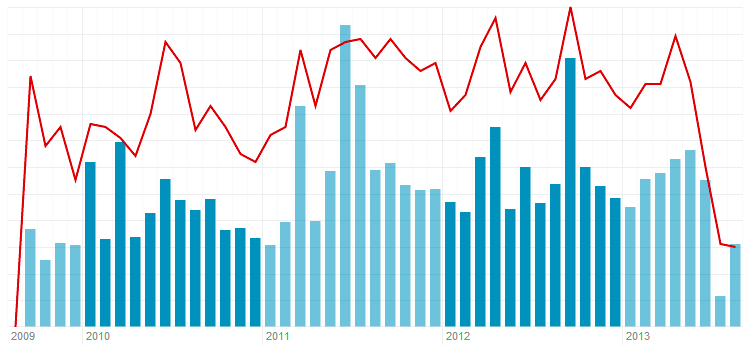 Today we welcome Pressmaster, a very successful microstock powerhouse based in Russia. Pavel Orekhov, COO of Pressmaster, will give us insights into their way of work and share good advice with you. Enjoy!
Today we welcome Pressmaster, a very successful microstock powerhouse based in Russia. Pavel Orekhov, COO of Pressmaster, will give us insights into their way of work and share good advice with you. Enjoy!
Tell us, where do you live and where are you from? Is that where you produce your photography?
Thank you very much for inviting us to chat in your series of interviews. It’s a pleasure for us! Let me tell you shortly about Pressmaster.
We are the production company from the start; we are not one photographer. Dmitriy Shironosov, co-owner of our company, is the person who holds all the proprietary rights including copyright to the content that we produce. I’m Pavel Orekhov, COO of our company.
Our team includes: production studio chief, art-director, shooting administrator, casting manager, photographers, assistant photographer, stylists, group of retouchers, group of submitters, accountant, legal advisor, driver and footage team.
We are from Chelyabinsk city, Russia. It is the place where we shoot 90% of our images.
When did you discover your interest in photography?
Pressmaster started in the beginning of 2007 with clear business goals. So our approach is that stock photography is extremely interesting, emotional, sometimes funny, and very competitive business where the team effort plays a great role.
How did you find microstock and why did you get involved? Has it changed your life?
Dmitriy found microstock photography to be a great opportunity, and as an entrepreneur at heart he was simply unable to pass by. For me it was also a great challenge to build a successful business from scratch on a worldwide market. It taught me a lot, first of all to think big; and I continue to learn with every road turn.
Thank you for image! What inspired you to take this picture?
To tell you the truth it was a regular planned shoot and the image was a regular good image with good models for us, but had nothing extremely special. Only now I understand that this image is a professional combination of success factors: the general concept is popular, the selection of models is good, the smiles don’t appear to be staged, the natural light is great, the composition is well done, as they naturally bend over when somebody hails them from below in real life. The very important thing is that their clothes are simple. They were modern several years ago and they are modern today.
What does this image’s revenue chart tell you?
The revenue chart is from Shutterstock, and it shows a good long-term selling image and made me think why it has proved to be such a long-term selling product. Mainly to determine how we can apply these features to every single image we shoot. In a book that tells a success story it would be easy to repeat all such features. But in real life, I understood that the combination of these features is unique.
They are hardly scalable and cannot be applied to every shoot (one is not a factory), but it is possible at least to pay attention to the important ones while preparing each shoot. That raises our chances to create a popular image.
One more thing plays a crucial role in the popularity of the image – the finger that pushes the button of camera… the talent of the photographer!
Did you expect such a revenue chart? Are you happy with it?
No, I didn’t expect it. As I told you, it was a regular shoot and a regular nice image. We have hundreds if not thousands of nice images, “nice” from a market point of view. Definitely we are happy with it, because very few of our images are popular for such a long period.
I remember you mentioned in your Microstock Lifecycle article, that the active sales period of an image today is about half a year. Indeed, I can confirm that the popularity of our “nice” images ranges from three months to two years max.
You should also consider the competitive situation at each agency when the image enters the market. If the competition is not very high and the image is considerably better than the market from the start, it holds very sustainable position in search results and sells longer.
The microstock market is huge. How do you analyze the market? Is it an important part of your workflow?
Definitely market research is a very important part of our workflow. And Stock Performer helps us in this analysis greatly! Thank you!
We have a content production strategy and submission schedule each month based on our Pressmaster experience. In addition we always monitor general market trends, analyse our own trends using StockPerformer, think of new specific concepts and update the strategy every half a year.
Do you believe in “quantity” or “quality”? What is most important for you and why?
Both aspects are equally important. Synergy effect plays a great role at this market. We submit 600 images per month; shoot on average 17 different general topics per month and try to keep the quality standards as high as possible for every shoot.
What does your typical production process look like?
Our art director divides all general topics amongst our photographers and schedules them in our shooting calendar. The art director then holds meetings with each photographer, stylist, shooting administrator and discusses the shooting in detail: concepts, subjects, models, location, and style.
They save all the information in a shooting plan. This plan is used by the casting manager to invite the appropriate models. The shooting administrator organizes the shooting while the stylist prepares the clothes, props and decoration.
Once the shooting is complete, the photographer and art-director select the images for upload. Our retouching team retouches them, submitters create metadata and finally we upload them.
Would you recommend photographers to take risks and invest in employees or assistants, or outsource, to help them in their production process?
I assume a lot of stock photographers already shoot with stylist, and do not do retouching themselves. It’s very hard and time consuming to do it all yourself. So I guess it’s already almost a market standard to do these parts of the job + keywording with the help of assistants.
Whether you should add more people to your workflow depends on yourself very much. Are you ready to work in a team? A lot of photographers prefer to work alone where everything depends on themselves only, and that’s ok. Are you able to lead your team? That’s another talent and requires a lot of energy. Do you want to scale your volumes or are you generally satisfied with your outcome? What do you want? It’s very personal issue. There are no general tips here that will help every photographer.
Try! Invite somebody for one shoot and analyze how you feel.
Where do you think the stock photography business is going? How do you see the next years?
It’s always difficult to forecast the future. We believe that the market will need live photography. Not handshakes on a white background or business person with a “cheesy” smile…this stuff is already oversupplied.
From our point of view the general trend is natural authentic images full of atmosphere that make you dive into a situation and feel like you are inside that very moment of life.
What is your advice to remain a successful stock photographer in upcoming years?
Do you mean to give advice to those photographers that are already good in the market?! Well, it’s risky. I’m sure each of them can give me their own advice! Ok, mine will be the following.
Know your strengths. Focus and polish your style to make it truly unique. Shoot only the photography that you are able to shoot much better than the images available in the current market. Then plan some time for experiments, do not stand in one place. And continue to have fun! In any case, you can really shoot well only what you like.
Tell us, when you are not doing photography, how do you relax and enjoy your free time?
Our team consists of very different and interesting people. We relax differently too. So our guys like to: sleep, sleep a lot, play chess, write poems and songs, travel, consider Myers Briggs personality types, skateboard, develop the artificial intelligence, surf, learn Korean and have fun with Korean theme, swim, make couchsurfing, play with our children, wakeboard, cycle, gather mushrooms, engage in fitness, become interested in black swan theory, fish, ski, draw, sculpt in clay, learn game theory, and cheer for our hockey team!
Thank you very much for your time, it was a pleasure talking to you!
Thank you very much for inviting us! And thank you for StockPerformer – such a great analysis tool!
If you haven’t joined Stock Performer yet, join the free trial now!
You enjoyed this interview? Then read more here!
Troels Haahr Graugaard from SquaredPixels

